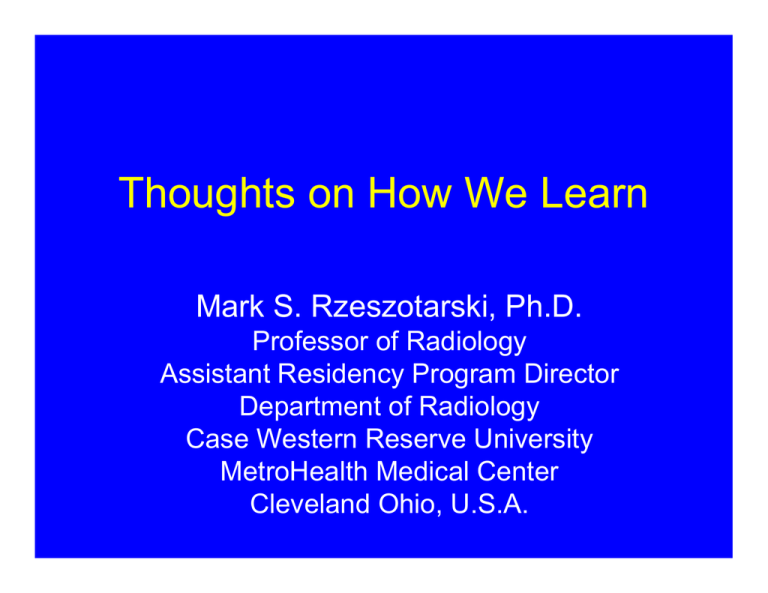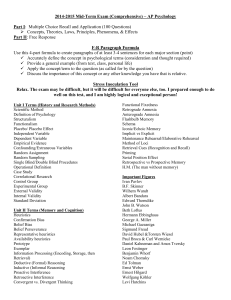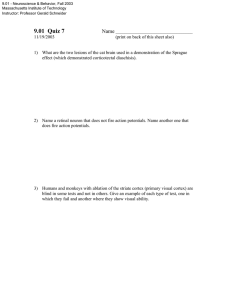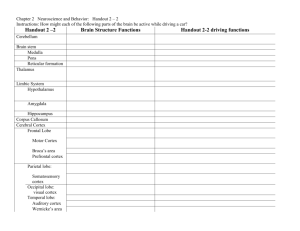Th ht H W L
advertisement

Th Thoughts ht on How H W We L Learn Mark S. Rzeszotarski, Ph.D. Professor P f off Radiology R di l Assistant Residency Program Director Department of Radiology Case Western Reserve University MetroHealth Medical Center Cleveland Ohio, U.S.A. How Do We Learn? • Understanding how the brain functions is helpful in facilitating both teaching and g learning. • A very simple model of the brain1 can be used to demonstrate how we learn and, perhaps, make us more effective teachers. 1The Art of Changing the Brain, James E. y Publishing, g Sterling, g Virginia g Zull, Stylus How Do We Learn? Sensory Cortex • Receives sensory input from the outside world: • • • • • • Vision H i Hearing Touch Position Smell Taste • The more senses used, the better the comprehension. Free food helps helps, too (stimulates smell and taste and the pleasure portion of the brain) Temporal Integrative Cortex • • • • Memory formation Language comprehension Processes visual information: Where and What Memory formation is facilitated if the information is similar to something already known known. Analogies and similar prior cases are important for learning. We build knowledge based on our previous experiences. • Relate the physics to something the resident already knows, or link it to an interesting clinical case. Passive Learning • • • • • Didactic lectures Read a book/internet yp y 10-30% Retention is typically No reinforcement of information p of analysis y or p problem solving g No development skills Frontal Integrative Cortex • • • • • Problem solving Decision making Assembly y of language g g Making judgments and evaluations Directing the actions of the body • Important for analysis and problem solving, not used in passive learning Motor Cortex • • • • Speech Writing Locomotion Stimulates the sensory inputs, completing the feedback loop loop, thereby enhancing comprehension (Examples: taking notes, highlighting, repeating a phrase, holding and examining an x-ray tube anode) Limbic Cortex • • • • Emotion center of the brain Pleasure (basal structures) Fear (amygdala) ( ) Can inhibit or enhance learning: “Deer in the headlights” (equations) versus “Physics headlights Physics is Fun” Fun (neat demonstration). Food is an enhancer! • Need to prevent negative emotions when teaching. Create a positive environment conducive to learning. Must always be cognizant of your audience emotion level level. • Reset it when necessary Habituation • Neuron firing g rates diminish if the same stimulus is provided over time. • Auditory habituation – the boring speaker • Visual habituation – no images or the same image shown for a long time • Occurs O after ft 10-20 10 20 minutes i t • Can be reset by a change of stimulus, such as the use of audience response response, calling on a student , a loud noise or tag-team teaching Active Learning • Utilizes the full circle of learning in the brain, reinforcing memoryy and facilitating g our development p of analysis y and problem solving abilities. • Active learning techniques used by the author: 1 Didactic lectures using audience interaction or audience 1. response technology 2. Q&A problem sessions – small group board review 3. Teaching file case conferences with added physics 4. Tag-team teaching – mix clinical cases with physics 5 Web-based 5. Web based instruction, instruction assigned during rotations 6. Small group discussion – at the PACS review workstation (protocols, pulse sequences, artifacts) 7. Labs, demonstrations – new resident orientation Conclusions • Understanding how we learn can make us more effective teachers and learners. • Active teaching/learning g gp paradigms g are most effective. Use several and be repetitive so that memories are reinforced. • Recognize that adult learning styles vary considerably and try to always create a positive l learning i environment i b by minimizing i i i i ffear and d anxiety. Generation X / Y residents want full control of their education education.









